Table of Contents
Featured Inuit Dog Owner: Dr. Lucien Ockovsky
The First Official ISDI Gathering
Nunavut Quest 2001 Diary
The Song of the Glacier
An Arctic "Fish Story"
Defining ISD Purity
Distemper in the North
Brucellosis in Arctic Marine Mammals: A threat to team dogs?
Poem: But, I must be dreaming, that's years ago...
Book Review: the latest Coppinger book
Janice Howls: Who Belongs in the ISDI?
Page from a Behaviour Notebook: Inuit Dog Stereotypes
Frankly Speaking: Zombies
Navigating This
Site
Index of articles by subject
Index
of back issues by volume number
Search The
Fan Hitch
Articles
to download and print
Ordering
Ken MacRury's Thesis
Our
comprehensive list of resources
Talk
to The Fan
Hitch
The Fan
Hitch home page
ISDI
home page
Editor: Sue Hamilton
Webmaster: Mark Hamilton
Contents of The Fan Hitch Website and its publications are protected by international copyright laws. No photo, drawing or text may be reproduced in any form without written consent. Webmasters please note: written consent is necessary before linking this site to yours! Please forward requests to Sue Hamilton, 55 Town Line Rd., Harwinton, Connecticut 06791, USA or mail@thefanhitch.org
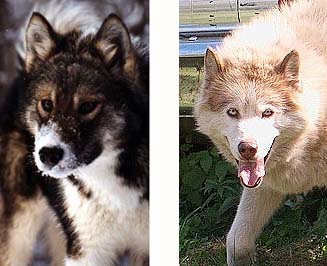
Which is the pure ISD? Answer at bottom of the page.
Phenotype and the Importance of the Purity of the ISD
by Geneviève Montcombroux
The question of purity of the breed is a most important one for everyone concerned about the survival of the Inuit Sled Dog. And this question is not merely an abstract one, for how does one determine whether a given specimen is pure when there are only external characteristics to go by?
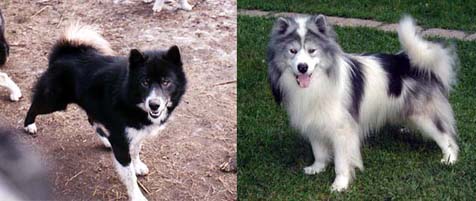
Type: Short
Coat
Type:
Long Coat
Both males of known purity
It could be that the ISDI is facing an impossible task in striving to maintain the breed in its pure state. I believe that with perseverance and careful research, it is possible to do so. The dog's phenotype, that is, its appearance resulting from the interaction of the genotype and the environment, will naturally differ in dogs from one region compared with those from another. Climate, nutrition, breeding influences and work habits all play a part in determining the outward appearance of the animal. Despite the multiplicity of "types" in the Inuit Dog, there are a few significant landmarks that do not change and that help us recognize a pure specimen from one whose line has been adulterated by another breed. The desirable phenotype can be established by a close examination of early photographs, drawings and prints made by explorers and whalers who penetrated the Arctic in the nineteenth century.
We are not able to establish when the contamination of the breed began in the Arctic, but even as late as 1950, judging from the available photographs - many of which are of excellent quality - it seems safe to say that large numbers of the dogs in the more remote settlements and outcamps were still pure. I have met elders in the North who have a perfect "eye" for selecting the best dogs, and know intuitively what to look for in physical traits and characteristics of temperament.
From my discussions with these elders, coupled with my own research findings and my study of what other authors have written on the subject, I am convinced that certain physical attributes remain constant through successive generations.
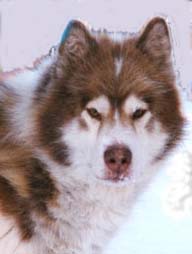
Mature male head
Montcombroux photo
The head is always a prime indicator. The skull must be broad and wedge shaped. The term "broad" has to be defined in relation to the shape of the skulls of other breeds. A German Shepherd, for instance, has a narrower skull compared to an ISD, so does a Retriever and a wolf.
The ears are always planted on the side of the head, not on the top, so that when they are held erect, there is a wide space between them. Although they are highly mobile and will change direction according to the mood the dog is expressing, they are always straight, never bent. The ISD can angle its ears sideways but does so rarely. The ears are small in comparison to the ears of a Siberian Husky or German Shepherd, and always taper to a rounded tip, with a straight clean line to the base.
The eyes are set close to the bridge of the muzzle in a marked slanted position. They are small in comparison to other breeds and have a definite almond shape, very similar to a wolf's eyes.
The nose is of medium length, slightly shorter than a wolf's, a German Shepherd's or a Retriever's, but longer than a Samoyed's. It has a robust appearance, not as pointed as a wolf's but not as square and thick as that of most Malamutes.
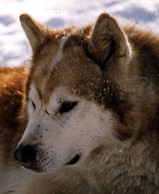
Mature female head Hamilton
photo
The lips have a slight downturn at the corners of the mouth, which lends the dog an almost disdainful expression. This shape is not a second fold of the lips, as in the bulldog-type breeds, nor is it a drooping lip like a St. Bernard.
One observation I have made and which is corroborated by others who have experience with this breed is that the palate of a pure dog is always mottled in color. An all black dog will have more pigmentation and the roof of its mouth will appear almost entirely black, though some small pink patches should still be visible. This characteristic has no scientific basis, but I mention it for your interest.
Two other traits that seem to be constant are the shape and size of the paws, and the carriage of the tail. The ISD's paws are oblong in shape. One could state with some certainty that a dog with distinctly rounded paws is not a pure dog. A telltale feature of all dogs belonging to the Spitz family is that their tails curl up over the back. What separates the ISD's tail from the shape of other Spitz breeds is that it rises straight from the rear and curls immediately over and down one side of the back. There is very little daylight to be seen under the curl, in contrast to a Siberian Husky or a Malamute tail, which arches straight over the back and leaves enough space to pass one's hand through. Yet the ISD's curl is not as tight as that of an Akita or a Norwegian Elkhound.
The length of the legs, the size of the body - whether slender or squarish, the depth and width of the chest are largely influence by nutrition and the amount of work the dog does, as well as by the age at which it was put into harness.
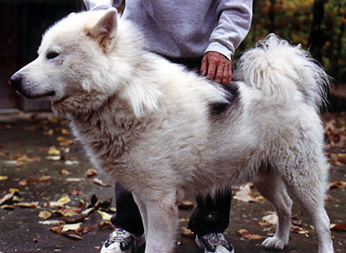
Schmidt
photo
The number of recognizable/pure Inuit Sled Dogs in North America is not very encouraging, and it poses a threat to its survival, and could lead to a genetic bottleneck if owners and breeders of ISDs do not take precautions. At the moment, it seems that the breed's salvation lies in Greenland. On numerous occasions in the early twentieth century, Canadian Inuit hunters supplied their Greenland cousins with dogs after their own had been wiped out by epidemics. It is perhaps time for Greenland to return the favor. The Greenlanders, buoyed by favorable government support, have maintained more of their traditional culture, in which sled dogs play an integral part, than their North American counterparts. The Canadian Inuit have adopted mechanized means of transport, with tragic consequences for the dogs.
Some people have suggested that we should breed the Inuit Sled Dog with the Malamute, or other northern breed, to replenish the gene pool. What these well-meaning people fail to understand is that cross-breeding is precisely what pushed the ISD to near-extinction in the first place. The introduction of genes from another breed will not strengthen the Inuit Sled Dog but will result in a mongrel, a mutt. This deliberate procedure to try to "improve" the breed has already been tried. The offsprings of this mixed breed experiment are still causing the ISDI headaches.
One important feature of the Inuit Sled Dog is that, at present, the breed contains no known genetic defects, diseases or conditions, which is not the case in every other breed. It would be madness to introduce another breed's genes and thereby endanger both the genetic health and the purity of the ISD.
Owners of other northern breed are sometime looking to the ISD to help revitalize their animals and solve some of the breed's inherited health problems. While the ISDI is not able to exercise control over what happens in individual cases, the result is the same: a waste of good Inuit Sled Dog genes.
I have high hopes that the DNA study, undertaken by Peter Salovainin in Sweden, will enable us to identify pure ISD specimens, but we have a long way to go before the results can permit us, if ever, to breathe easier.
In the meantime, we must rely on identifying the ideal phenotype. A drawback to this method is that it is not possible to tell if a puppy has the right phenotype until it is at least six months old, when it shows most of its adult characteristics. From that age on, it will certainly fill out and develop its muscle mass, but those traits I discussed above will be clearly recognizable.
The Inuit Sled Dog is a magnificent animal, with its headstrong, courageous, exasperating and affectionate nature. It possesses incredible stamina and toughness that has been its salient feature down through the centuries. For the sake of this unique breed, we ought to ensure that we only breed the purest and the fittest specimens, and neuter and spay any accidental offspring of undesirable matings.
Answer to purity quiz picture: Neither. Both the brown-eyed female (l) and the blue-eyed male (r) are known to be of mixed heritage. (Ed.)